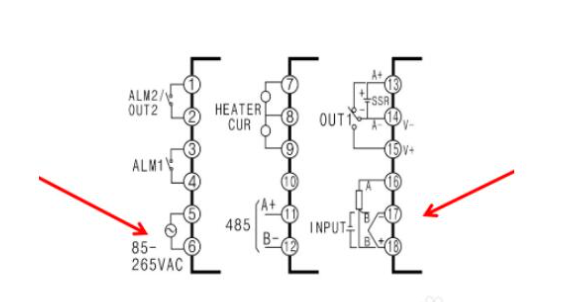How to wire the digital display instrument
How to wire the digital display instrument
Taking this wiring diagram as an example, let's first look at the power supply and sensor connections. Pins 5 and 6 are for power supply (AC 85-265V), while pins 16, 17, and 18 are for sensor connections. For thermocouples (K, E, J, etc.), connect the positive wire to pin 18 and the negative wire to pin 17. For thermal resistors (PT100, CU50), connect pin 16A to one wire, and pins 17B and 18B to the other wire. If PT100 has only 2 wires, short-circuit pins 17 and 18.

Next, let's look at the heating output and alarm output. According to this diagram, OUT1 represents the heating output. If it is a relay output, connect the heating element to pins 14 and 15. If it is an SSR (Solid State Relay) output, connect pin 13+ to the positive side and pin 14- to the negative side. If it is an analog output (4-20mA, 0-10V, etc.), connect the current output to pins 13+ and 14-, and the voltage output to pins 15+ and 14-. ALM1 and ALM2 represent alarm outputs. Connect alarm 1 to pins 3 and 4, and alarm 2 to pins 1 and 2. The alarm mode and deviation values can be adjusted through internal parameters.
Finally, let's look at the remaining current detection and RS485 communication functions. This meter can connect two current transformers to detect the current in the heating system. Pins 7, 8, and 9 are for the current detection, with pin 8 as the common terminal. Pins 11 and 12 are for RS485 communication, where pin 11 is for A+ and pin 12 is for B-. This allows remote monitoring and temperature adjustment.
 English
English
How Does an Energy Meter Work
An energy meter is a vital device used to measure the amount of electrical energy consumed by a home, business, or industrial facility. As electricity usage continues to rise across the world, understanding how an energy meter works helps consumers make smarter decisions about energy efficiency and cost management.
Read MoreHow to Read an Energy Meter
Understanding how to read an energy meter is an important step toward managing electricity consumption effectively. Whether you’re a homeowner, business owner, or energy professional, learning to interpret your meter readings can help you monitor usage, reduce costs, and identify opportunities to improve energy efficiency. With both analog and digital models in use today, the method of reading an energy meter depends on the type of device installed.
Read MoreHow Do Energy Meters Work
An energy meter is a crucial device used to measure and record the amount of electrical energy consumed by a home, business, or industrial facility. As the global focus on energy efficiency and smart power management increases, understanding how energy meters work has become essential for both consumers and professionals in the energy sector.
Read More